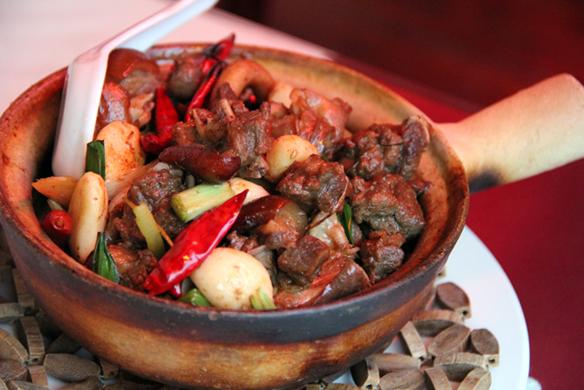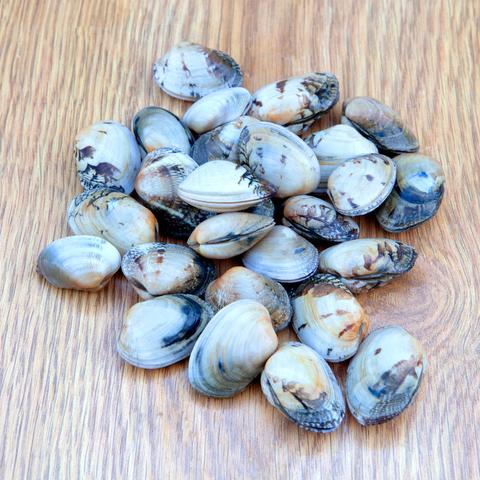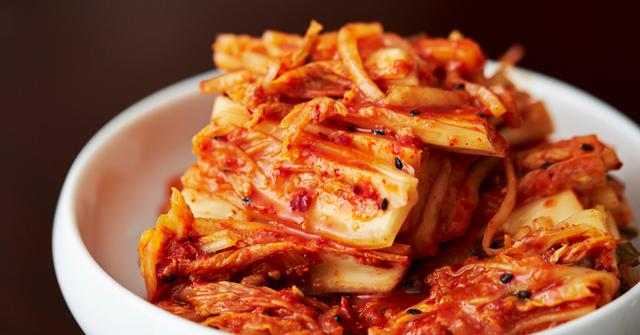
Discover the tantalizing flavors of kimchi, a traditional Korean dish that combines spicy, sour, and umami tastes. Dive into a world of fermented vegetables, fiery chili peppers, and a burst of garlic and ginger. Experience the unique tanginess and crisp texture that make kimchi an irresistible culinary delight. Join us on a journey to unravel the distinct taste sensations of this beloved Korean staple.
Exploring the Flavors of Kimchi: What Does It Taste Like?

Kimchi is a fermented side dish that offers a unique and complex taste. The flavor of kimchi can vary depending on the ingredients used and the length of fermentation. Generally, kimchi has a tangy and sour taste, with hints of saltiness and umami. The fermentation process gives kimchi its distinct acidity and sharpness. As you chew the vegetables, you may also experience sweetness and tanginess. The use of bold seasonings like gochugaru (Korean chili powder) adds spice to the dish, ranging from mild to very spicy depending on the amount used. Overall, kimchi is a flavorful combination of different tastes that can be adjusted to suit individual preferences.
Factors Affecting Kimchi’s Flavor
– Ingredients: Different types of kimchi are made with various vegetables such as napa cabbage, Korean radishes, or cucumbers. Each vegetable brings its own unique flavor to the dish.
– Seasonings: The seasoning paste used in kimchi typically includes garlic, ginger, green onion, and gochugaru. These seasonings contribute to the overall taste profile.
– Fermentation Time: The longer kimchi ferments, the more intense its flavors become. Over time, ingredients like garlic may become stronger in taste.
Types of Kimchi
There are hundreds of styles of kimchi available, each with its own flavor profile. Some popular variations include:
– Napa Cabbage Kimchi: This is one of the most widely recognized types of kimchi outside Korea. It has a spicy and tangy flavor.
– Kkakdugi: Made with cubed radishes, this type of kimchi has a crunchy texture and a slightly sweet and spicy taste.
– Oi Sobagi: This quick cucumber kimchi is popular in the summer months and has a refreshing and tangy flavor.
Enjoying Kimchi’s Flavors
Kimchi can be enjoyed on its own as a side dish or incorporated into various recipes. Its versatile taste makes it a great addition to many dishes, including:
– Kimchi Fried Rice (Kimchi Bokkeumbap): The flavors of kimchi complement the savory rice dish.
– Savory Kimchi Pancakes (Kimchi Buchimgae): Kimchi adds a tangy and spicy kick to these crispy pancakes.
– Kimchi Dumplings (Kimchi Mandu): These dumplings are filled with a flavorful mixture of kimchi and other ingredients.
– Soba Noodle Salad (Bibim Guksu): The tanginess of kimchi enhances the flavors of this refreshing noodle salad.
– Stir-Fry, Noodle, and Rice Dishes: Adding kimchi to stir-fries, noodles, or rice dishes can elevate their taste with its unique flavors.
Exploring the flavors of kimchi allows you to experience the complexity and diversity of Korean cuisine. Whether you enjoy it on its own or incorporate it into your favorite recipes, kimchi offers a delicious and distinctive taste that is sure to please your palate.
Unveiling the Taste of Kimchi: A Tangy and Complex Delight
Kimchi is a tangy and complex dish that offers a unique flavor profile. The taste of kimchi can vary depending on how it’s made and what ingredients are used. With hundreds of different types of kimchi available, each with its own distinct flavors, there is something for everyone to enjoy.
The most widely recognized version of kimchi is made with napa cabbage brined with salt and seasoned with garlic, ginger, green onion, and gochugaru (Korean chili powder). This version has a spicy and slightly sour taste that is both refreshing and addictive. Other types of kimchi can be made with Korean radishes, cucumber, or even the addition of shrimp or anchovies for added depth of flavor.
The fermentation process gives kimchi its unique taste. As it ferments, the flavors develop and intensify, resulting in a rich and complex flavor profile. The longer kimchi ferments, the more pronounced the flavors become. Some ingredients like garlic may become more intense over time.
Kimchi’s taste also depends on personal preference. Some people prefer milder versions of kimchi that are less spicy, while others enjoy the heat and bold flavors that come from using more gochugaru in the recipe. There are also variations like baek kimchi or white kimchi that are not spicy at all.
Overall, kimchi offers a combination of sourness, spiciness, umami, sweetness, and tanginess. It is a versatile dish that can be enjoyed on its own as a side dish or incorporated into various recipes to add depth and complexity to a meal.
Here are some ways to describe the taste of kimchi:
– Tangy: Kimchi has a tangy flavor that comes from the fermentation process.
– Spicy: Depending on the amount of gochugaru used, kimchi can range from mild to very spicy.
– Umami: Kimchi has a rich and savory taste that comes from the combination of ingredients like garlic, ginger, and fish sauce.
– Sour: The fermentation process gives kimchi a slightly sour taste that adds brightness to the dish.
– Sweet: Some versions of kimchi may have a hint of sweetness, especially if fruits like pear or apple are added to the recipe.
In conclusion, kimchi is a tangy and complex delight that offers a unique flavor experience. With its rich history and cultural significance in Korean cuisine, kimchi has become an iconic dish that transcends its role as a humble side dish. Whether you prefer it spicy or mild, there is a type of kimchi out there to suit your taste buds.
The Flavor Spectrum of Kimchi: From Spicy to Sweet and Everything in Between
Kimchi is known for its rich and complex flavors, offering a wide range of tastes from spicy to sweet and everything in between. The taste of kimchi can vary depending on the ingredients used and how long it has been fermenting.
One of the most widely recognized versions of kimchi is made with napa cabbage, which is brined with salt and seasoned with garlic, ginger, green onion, and gochugaru (Korean chili powder). This version has a tangy and spicy flavor that is both refreshing and invigorating.
Other types of kimchi can be made with ingredients such as Korean radishes, cucumber, or even the addition of fermented shrimp or anchovies. These variations offer different flavor profiles, ranging from mild and crunchy to salty and pungent.
The longer kimchi ferments, the more intense its flavors become. Over time, the sourness increases while other tastes such as sweetness and tanginess also develop. The use of bold seasonings like gochugaru adds depth and complexity to the overall taste of the kimchi.
With so many varieties made from different vegetables and seasonings, kimchi can be customized to suit nearly any palate or dietary need. Whether you prefer spicy or mild flavors, there is a type of kimchi that will surely satisfy your taste buds.
In addition to its diverse flavors, kimchi also offers numerous health benefits. It contains probiotics that promote gut health and prebiotics that help good bacteria grow. Kimchi is also a great source of vitamins A and C.
Overall, the flavor spectrum of kimchi is vast and exciting. From spicy to sweet, each bite offers a unique combination of tastes that reflects the rich culinary heritage of Korea. Whether enjoyed on its own or incorporated into various dishes, kimchi is sure to add a burst of flavor and complexity to any meal.
Kimchi’s Taste Journey: How Fermentation Transforms the Flavors

Kimchi undergoes a fascinating taste journey as it goes through the process of fermentation. The flavors of kimchi are transformed and intensified, resulting in a rich and complex taste profile.
During fermentation, the lactobacillus bacteria present in kimchi convert the sugars in the vegetables into lactic acid. This process gives kimchi its tangy and sour flavors. The longer kimchi ferments, the more pronounced these flavors become.
In addition to the sourness, kimchi also develops a salty taste during fermentation. The initial salting of the vegetables helps draw out moisture and create a brine, which contributes to the overall saltiness of the dish.
The umami flavor is another important component of kimchi’s taste. Umami is often described as a savory or meaty taste, and it adds depth and complexity to the flavor profile of kimchi. Ingredients like fish sauce or fermented shrimp are commonly used in kimchi recipes to enhance this umami taste.
As kimchi ferments, it also develops a sharp acidity that adds brightness and freshness to its flavor. This acidity cuts through the richness of other ingredients and balances out the overall taste of kimchi.
The length of fermentation time can also impact the flavor of kimchi. Over time, ingredients like garlic intensify in flavor, adding an extra punch to the overall taste profile.
Overall, kimchi’s taste journey through fermentation results in a combination of sourness, saltiness, umami, and sharp acidity. It is this unique blend of flavors that makes kimchi such a beloved staple in Korean cuisine.
Unlocking the Secrets of Kimchi’s Taste Profile: A Guide for Food Lovers
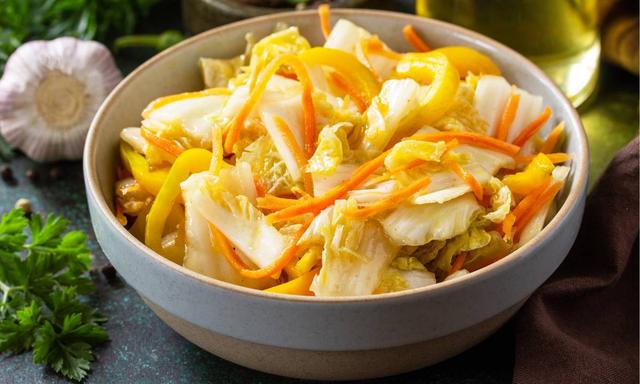
Kimchi is a complex and flavorful dish that offers a unique taste profile. With hundreds of different types of kimchi available, the taste can vary dramatically depending on the ingredients and fermentation process used. Some common flavors found in kimchi include sourness, saltiness, spiciness, sweetness, tanginess, and umami.
The fermentation process gives kimchi its distinct sour and salty flavors. As the vegetables ferment, lactic acid is produced, giving the dish its tangy taste. The addition of seasonings such as garlic, ginger, and gochugaru (Korean chili powder) adds depth and spice to the kimchi. The longer kimchi ferments, the more intense these flavors become.
Other tastes such as sweetness and tanginess come through while chewing the vegetables in kimchi. This can be attributed to the natural sugars present in the vegetables that are converted into lactic acid during fermentation. The use of bold seasonings like gochugaru and salted seafood also contribute to the overall complexity of flavors in kimchi.
Each type of kimchi has its own unique taste profile based on the specific ingredients used. For example, napa cabbage kimchi is known for its crisp texture and slightly sweet flavor. Radish kimchi (kkakdugi) has a crunchy texture with a spicy and refreshing taste. Cucumber kimchi (oi sobagi) is often enjoyed during hot summer months for its coolness and mild spiciness.
Overall, kimchi offers a rich and diverse taste experience that can be tailored to suit individual preferences. Whether you prefer mild or spicy flavors, there is sure to be a version of kimchi that will satisfy your palate.
Some popular dishes that pair well with kimchi include Kimchi bokkeumbap (kimchi fried rice), Kimchi buchimgae (savory kimchi pancakes), Kimchi mandu (kimchi dumplings), Bibim guksu (soba noodle salad), stir-fry, noodle and rice dishes, and even grilled cheese sandwiches. The versatility of kimchi allows it to be incorporated into a wide range of recipes, adding a burst of flavor and complexity to any dish.
In conclusion, kimchi’s taste profile is a result of its fermentation process and the combination of various ingredients and seasonings. Its sourness, saltiness, spiciness, sweetness, tanginess, and umami flavors make it a unique and beloved staple in Korean cuisine. Whether enjoyed on its own or used as an ingredient in other dishes, kimchi offers a delightful culinary experience for food lovers.
From Umami to Tanginess: Understanding the Multidimensional Taste of Kimchi
Kimchi is a complex and multidimensional dish that offers a range of flavors. The taste of kimchi can be described as tangy, spicy, sour, salty, and umami. These flavors come from the fermentation process and the combination of ingredients used in making kimchi.
One of the key flavors in kimchi is umami. Umami is often described as a savory or meaty taste that adds depth and richness to dishes. In kimchi, umami comes from ingredients such as fish sauce, shrimp paste, or fermented seafood that are added to the seasoning paste. This umami flavor enhances the overall taste of kimchi and makes it incredibly satisfying.
In addition to umami, kimchi has a tangy and sour taste. This tanginess comes from the lactic acid produced during fermentation. As the lactobacillus bacteria convert sugars into lactic acid, it gives kimchi its distinctive tangy flavor. The longer kimchi ferments, the more pronounced this tanginess becomes.
Kimchi also has a spicy kick to it. The level of spiciness can vary depending on how much gochugaru (Korean chili powder) is used in the recipe. Some versions of kimchi can be quite mild, while others can be very spicy. The spiciness adds another layer of complexity to the overall taste profile of kimchi.
Salty is another flavor that you will find in kimchi. Salt is used during the brining process to draw out moisture from the vegetables and create a brine. This saltiness helps preserve the vegetables and also enhances their natural flavors.
Lastly, there are hints of sweetness in some types of kimchi. This sweetness comes from ingredients like sugar or fruits that may be added to balance out the other flavors.
Overall, the taste of kimchi is a harmonious blend of tanginess, spiciness, umami, saltiness, and sometimes sweetness. The combination of these flavors creates a unique and addictive taste that keeps people coming back for more.
Here are some key points about the taste of kimchi:
– Kimchi has a multidimensional taste that includes tanginess, spiciness, umami, saltiness, and sometimes sweetness.
– Umami adds depth and richness to the overall flavor profile of kimchi.
– The tangy and sour taste comes from lactic acid produced during fermentation.
– The level of spiciness can vary depending on the amount of gochugaru used in the recipe.
– Saltiness helps preserve the vegetables and enhances their natural flavors.
– Some types of kimchi may have hints of sweetness from ingredients like sugar or fruits.
Understanding the different flavors in kimchi can help you appreciate its complexity and enjoy it even more. Whether you prefer mild or spicy kimchi, there is a version out there that will suit your taste buds.
The Art of Tasting Kimchi: Discovering its Rich and Diverse Flavor Palette
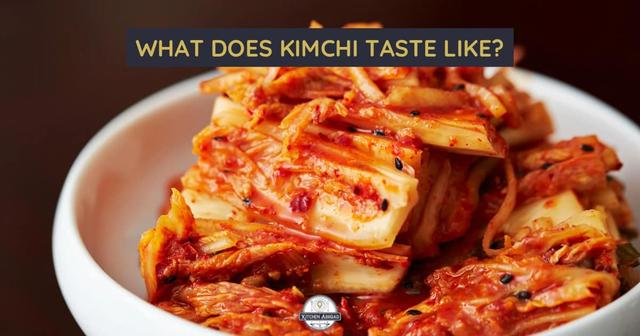
Kimchi is a dish that offers a rich and diverse flavor palette. With hundreds of different types of kimchi available, each variation has its own unique taste. The flavor of kimchi can vary based on factors such as the ingredients used, the length of fermentation, and the seasonings added.
One of the key flavors in kimchi is its tanginess. The fermentation process gives kimchi its sour taste, which adds a refreshing and zesty element to the dish. Along with the tanginess, there is also a noticeable saltiness in kimchi due to the brining process. These flavors work together to create a balanced and savory profile.
In addition to the tangy and salty notes, kimchi also has a hint of sweetness. This sweetness comes from the natural sugars present in the vegetables used to make kimchi. As the vegetables ferment, these sugars are converted into lactic acid, which contributes to both the tanginess and sweetness of the dish.
The spiciness of kimchi is another prominent aspect of its flavor palette. The use of gochugaru, or Korean chili powder, adds heat and depth to the dish. Different varieties of kimchi can have varying levels of spiciness depending on how much gochugaru is used.
Along with these primary flavors, there are also subtle undertones that add complexity to kimchi’s taste. Garlic and ginger provide aromatic notes that enhance the overall flavor profile. Other seasonings such as fish sauce or fermented shrimp can contribute umami flavors that deepen the taste experience.
When tasting kimchi, it’s important to pay attention to how these different flavors interact with each other. The initial tanginess hits your palate first, followed by layers of saltiness, sweetness, spiciness, and umami. Chewing on the vegetables allows you to fully experience the range of flavors and textures that kimchi has to offer.
Exploring the diverse flavor palette of kimchi is a delightful journey that allows you to appreciate the complexity and artistry behind this iconic Korean dish. Whether you prefer a milder version or enjoy the fiery heat of a spicy kimchi, there is a flavor profile to suit every palate.
What to Expect When Eating Kimchi: A Culinary Adventure for Your Taste Buds
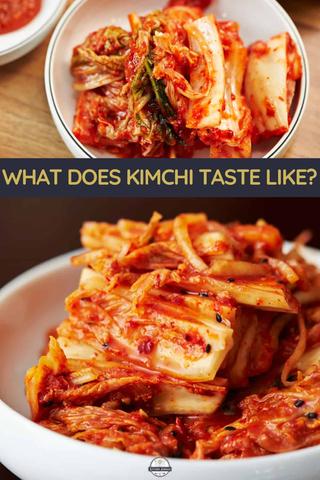
Kimchi is a unique and flavorful dish that offers a culinary adventure for your taste buds. Whether you’re trying kimchi for the first time or are already familiar with its taste, here’s what you can expect when eating this iconic Korean staple.
1. Tangy and Complex Flavor: Kimchi has a tangy and complex flavor profile that comes from the fermentation process. The combination of salty, sour, and umami flavors creates a rich and satisfying taste experience. The longer kimchi ferments, the more pronounced these flavors become.
2. Spiciness: While not all kimchi is spicy, many varieties do have a spicy kick. The level of spiciness can vary depending on the amount of gochugaru (Korean chili powder) used in the recipe. Some versions of kimchi are mild, while others can be quite fiery. If you’re sensitive to spice, look for milder options or rinse the kimchi before eating to reduce the heat.
3. Crunchy Texture: Kimchi typically retains its crunchy texture even after fermentation. This adds a satisfying element to each bite and contrasts well with other soft or tender ingredients in a meal.
4. Versatility: Kimchi can be enjoyed in various ways and incorporated into different dishes. It can be eaten on its own as a side dish or used as an ingredient in stir-fries, rice dishes, noodles, pancakes, dumplings, and more. Its versatility allows for endless culinary creativity.
5. Health Benefits: In addition to its delicious taste, kimchi offers numerous health benefits. It is rich in vitamins A and C and provides probiotics and prebiotics that promote gut health. However, it’s important to note that kimchi is high in sodium due to its preparation method, so moderation is key if you’re watching your sodium intake.
Overall, eating kimchi is a culinary adventure that delights the taste buds with its tangy and complex flavors, spiciness (if desired), crunchy texture, and versatility in various dishes. It’s a dish that not only satisfies the palate but also offers health benefits, making it a popular choice for many food enthusiasts.
Beyond Spiciness: The Surprising Tastes Found in Different Types of Kimchi
Kimchi is not just about spiciness. In fact, there are hundreds of different types of kimchi, each with its own unique taste profile. From mild and tangy to spicy and pungent, there is a kimchi to suit every palate. Some types of kimchi are made with ingredients like Korean radishes or cucumbers, while others incorporate fresh or fermented shrimp or anchovies for added depth of flavor. The variety in ingredients and seasonings used in kimchi makes it a truly diverse dish that can be customized to suit individual preferences.
One popular type of kimchi is made with napa cabbage, which is brined with salt and seasoned with garlic, ginger, green onion, and gochugaru (Korean chili powder). This version of kimchi is known for its vibrant red color and spicy kick. Another variation is white kimchi, also known as baek kimchi, which does not contain gochugaru and is therefore not spicy at all. White kimchi has a milder flavor profile that focuses on the natural sweetness of the vegetables.
The taste of kimchi also evolves over time as it continues to ferment. Initially, the flavors are sour, salty, and umami-rich due to the fermentation process. As the kimchi ages, additional flavors such as sweetness and tanginess develop. Ingredients like garlic become more pronounced over time. The longer you let your homemade kimchi ferment in the refrigerator, the more complex its flavors will become.
With so many options available, you can find a type of kimchi that suits your taste preferences perfectly. Whether you prefer mild or spicy flavors, tangy or sweet notes, there is a type of kimchi out there for you to enjoy.
Here are some examples of different types of kimchi:
1. Kkakdugi: This type of kimchi is made with cubed radishes instead of cabbage. It has a crunchy texture and a refreshing, slightly sweet taste.
2. Oi Sobagi: Oi sobagi is a quick cucumber kimchi that is popular in the summer months. It is made by stuffing cucumbers with a spicy seasoning paste, resulting in a crisp and flavorful dish.
3. Gat Kimchi: Gat kimchi is made with mustard greens and has a strong, pungent flavor. It is often enjoyed as a side dish or used in soups and stews.
4. Chonggak Kimchi: Chonggak kimchi is made with small, whole radishes and has a crunchy texture and tangy flavor. It is commonly served as a side dish or used in bibimbap (a mixed rice dish).
These are just a few examples of the many types of kimchi available. Exploring the different tastes and textures of kimchi can be an exciting culinary journey that allows you to discover new flavors and expand your palate.
So, the next time you think of kimchi, remember that it’s not just about spiciness. There are countless variations of this beloved Korean staple, each offering its own unique taste experience. From mild and tangy to spicy and pungent, there’s a type of kimchi out there for everyone to enjoy.
Decoding the Complex Flavors of Kimchi: A Guide for Curious Palates
Kimchi is a dish that offers a wide range of flavors and tastes, making it a fascinating culinary experience for those with curious palates. The taste of kimchi can vary greatly depending on the ingredients used and the fermentation process. Some versions of kimchi are spicy, while others are more mild. The flavor can also change over time as the kimchi continues to ferment in the refrigerator.
One of the key components that gives kimchi its distinct taste is gochugaru, a Korean chili powder. This bright red powder adds heat and spice to the dish, but the level of spiciness can be adjusted based on personal preference. Other seasonings such as garlic, ginger, and fish sauce contribute to the overall complexity of flavors in kimchi.
In addition to being spicy, kimchi also has sour and tangy notes. This comes from the fermentation process, which produces lactic acid that gives kimchi its characteristic tanginess. As you chew the vegetables in kimchi, you may also notice hints of sweetness and umami flavors.
The longer kimchi ferments, the more pronounced these flavors become. Ingredients like garlic can become stronger in taste over time. However, if you prefer a milder flavor profile, you can enjoy fresh or “white” kimchi that is made without gochugaru and is not spicy at all.
With so many different types of kimchi available, there is something to suit every palate. From traditional napa cabbage kimchi to variations made with radishes or cucumbers, each type offers its own unique combination of flavors.
Whether you prefer your kimchi spicy or mild, tangy or sweet, there is no shortage of options to explore when it comes to this beloved Korean dish. So why not embark on a culinary adventure and discover the complex flavors of kimchi for yourself?
In conclusion, kimchi is a flavorful and unique Korean dish that offers a spicy, tangy, and slightly sour taste. It is often described as refreshing and addictive due to its complex blend of flavors. Whether enjoyed on its own or as an accompaniment to various dishes, kimchi provides a delicious umami experience that surprises and delights the palate.
Learn More About Grilling
If you want to learn more about grilling, check out these other helpful resources!

